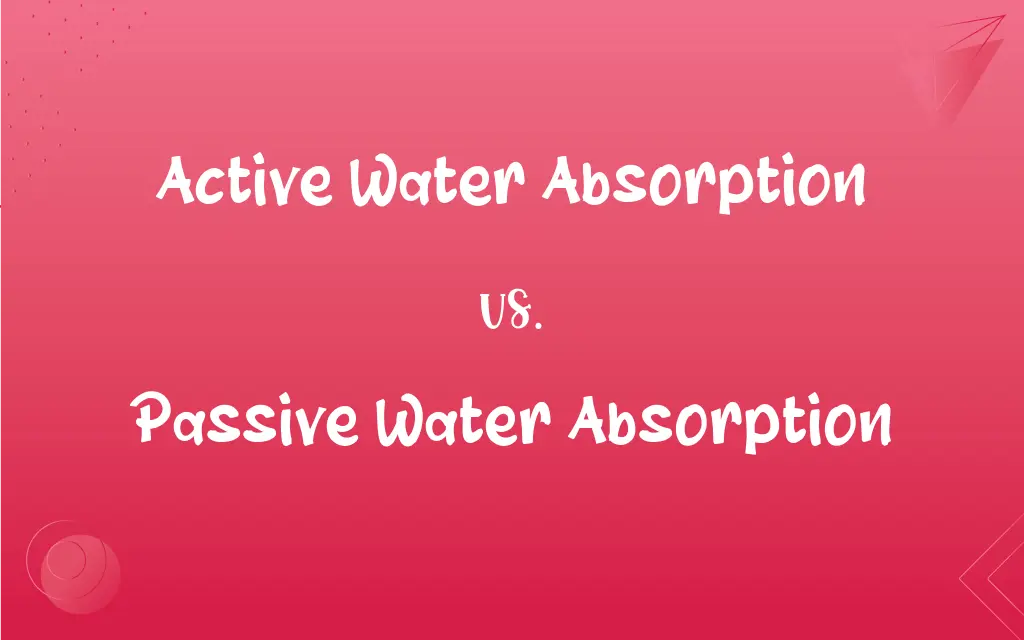Active Water Absorption vs. Passive Water Absorption: What's the Difference?
Edited by Janet White || By Harlon Moss || Updated on October 17, 2023
Active water absorption requires energy, occurring against a concentration gradient, while passive water absorption happens through osmosis, requiring no energy.

Key Differences
Active water absorption is a process that requires the expenditure of energy, typically in the form of ATP, to absorb water typically against a concentration gradient. On the other hand, passive water absorption doesn't require energy; it occurs when water moves following its concentration gradient, a process driven by osmotic potential differences.
In active water absorption, water is primarily absorbed through the roots in plants with the help of energy-consuming pumps that direct the movement of ions and thus water. Passive water absorption, in contrast, relies on the physical properties of water and the differential solute concentrations between the soil and plant.
Active water absorption allows plants to absorb water even when soil moisture levels are low or when the internal water concentration of plants is higher than in the external environment. Conversely, passive water absorption occurs readily when there's a high soil moisture level, promoting a concentration gradient favoring movement into the plant's roots.
The rate of active water absorption can be influenced by the metabolic activity of the plant, as it's an energy-dependent process. However, the rate of passive water absorption is determined by the soil's water potential and the plant's transpiration rate, not directly by the plant's metabolic energy.
In summary, active water absorption and passive water absorption are essential mechanisms that plants use to take up water from the environment. Active absorption provides advantages under water-stressed conditions, while passive absorption is beneficial when water is abundant and requires no energy expenditure.
ADVERTISEMENT
Comparison Chart
Word Origin
"Active" denotes energy use; "water absorption" signifies the process.
"Passive" indicates no energy use; "water absorption" is the process.
Syllables
Seven: ac-tive-wa-ter-ab-sorp-tion
Seven: pas-sive-wa-ter-ab-sorp-tion
Position in Alphabet
A is the 1st letter, earlier in the alphabet.
P is the 16th letter, following A.
Parts of Speech
"Active" is an adjective; "water" and "absorption" are nouns.
"Passive" is an adjective; "water" and "absorption" are nouns.
Active Water Absorption and Passive Water Absorption Definitions
Active Water Absorption
Active water absorption enables plants to maintain hydration even under adverse environmental conditions.
Despite the arid climate, active water absorption helped the crops survive the dry season.
ADVERTISEMENT
Passive Water Absorption
Passive water absorption is the process where water moves into plant roots driven by an osmotic potential gradient, requiring no energy.
The rainy season's abundant moisture simplified the plants' hydration through passive water absorption.
Active Water Absorption
Active water absorption is influenced by the plant's metabolic rate, as it requires energy in the form of ATP.
The plant's vigorous active water absorption was indicative of its high metabolic activity.
Passive Water Absorption
Passive water absorption is heavily reliant on the process of osmosis and the soil's water content.
Following the heavy rains, passive water absorption was predominant, quenching the thirst of the ground vegetation.
Active Water Absorption
Active water absorption is a crucial survival mechanism for plants in water-deficient soils.
Active water absorption was vital for the desert flora, supporting life in such an inhospitable environment.
Passive Water Absorption
Passive water absorption operates based on the concentration gradient between the soil water and the plant's internal water concentration.
The wetland's flora thrived, drawing sustenance through effortless passive water absorption.
Active Water Absorption
Active water absorption is the energy-dependent uptake of water by plants, primarily through their roots.
The dry soil conditions necessitated the plant's reliance on active water absorption to maintain its water content.
Passive Water Absorption
Passive water absorption, while energy-efficient, is dependent on environmental conditions, limiting its efficacy in dry settings.
In the drought-stricken region, passive water absorption was insufficient to sustain the local plant life.
Active Water Absorption
Active water absorption involves the transportation of ions against a concentration gradient, indirectly facilitating water uptake.
Through active water absorption, the roots could acquire water despite the higher internal concentration.
Passive Water Absorption
Passive water absorption occurs when the soil's water potential is higher than that of the plant's roots.
The well-irrigated fields facilitated passive water absorption, contributing to the lush greenery.
FAQs
What is passive water absorption?
Passive water absorption is the energy-free movement of water into plants due to osmotic potential differences.
Do both active water absorption and passive water absorption occur in all plants?
Yes, most plants utilize both active and passive water absorption, depending on environmental conditions.
What is active water absorption?
Active water absorption is an energy-dependent process where plants absorb water, often against a concentration gradient.
Are there environmental factors that affect active water absorption?
Yes, factors like temperature and soil pH can influence active water absorption.
Is passive water absorption effective in dry environments?
Passive water absorption is less effective in dry conditions due to reliance on soil water potential gradients.
Can passive water absorption create root pressure?
Yes, it can contribute to root pressure, especially in water-saturated conditions.
Can active water absorption occur without soil moisture?
Active water absorption requires some soil moisture, though it's effective even in low-moisture conditions.
Does passive water absorption occur at night?
Yes, passive water absorption can occur at any time, provided there's a suitable concentration gradient.
How fast is active water absorption compared to passive?
Active absorption rates are dependent on energy use and can be regulated, while passive is driven by environmental conditions.
Can overwatering affect passive water absorption?
Overwatering may harm plants, but it generally enhances passive water absorption due to increased soil moisture.
Are there waterborne pathogens that can be absorbed through passive water absorption?
Pathogens can travel with water, but whether they're absorbed passively depends on the plant's defense mechanisms.
How does passive water absorption work in saturated soils?
In saturated soils, passive water absorption is efficient as water readily moves into the roots following the concentration gradient.
Is active water absorption more prevalent in certain plant species?
Yes, plants in arid environments or those with high salt concentrations often rely more on active absorption.
Are there specific root structures associated with active water absorption?
Yes, root hair cells and endodermal cells are crucial for active water uptake.
Does passive water absorption influence plant nutrient uptake?
It can, as water movement often brings dissolved nutrients into the plant.
Is active water absorption affected by light?
Indirectly, since photosynthesis (light-dependent) produces the energy (ATP) that may fuel active water absorption.
How do plants balance active and passive water absorption?
Plants dynamically regulate both processes based on internal and external moisture and nutrient needs.
Does active water absorption require energy from the plant?
Yes, active water absorption requires energy, typically in the form of ATP.
Can passive water absorption alone sustain plant hydration?
This depends on environmental moisture; in humid or well-watered areas, passive absorption can be sufficient.
Are there adaptations that enhance active water absorption in desert plants?
Yes, adaptations like extensive root systems or nocturnal stomatal opening help optimize active water uptake.
About Author
Written by
Harlon MossHarlon is a seasoned quality moderator and accomplished content writer for Difference Wiki. An alumnus of the prestigious University of California, he earned his degree in Computer Science. Leveraging his academic background, Harlon brings a meticulous and informed perspective to his work, ensuring content accuracy and excellence.
Edited by
Janet WhiteJanet White has been an esteemed writer and blogger for Difference Wiki. Holding a Master's degree in Science and Medical Journalism from the prestigious Boston University, she has consistently demonstrated her expertise and passion for her field. When she's not immersed in her work, Janet relishes her time exercising, delving into a good book, and cherishing moments with friends and family.































































